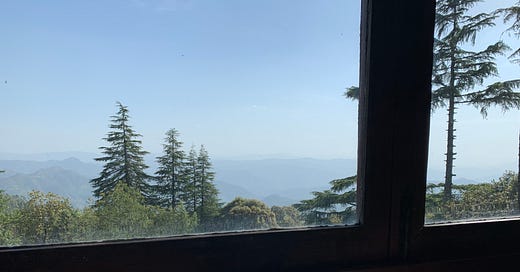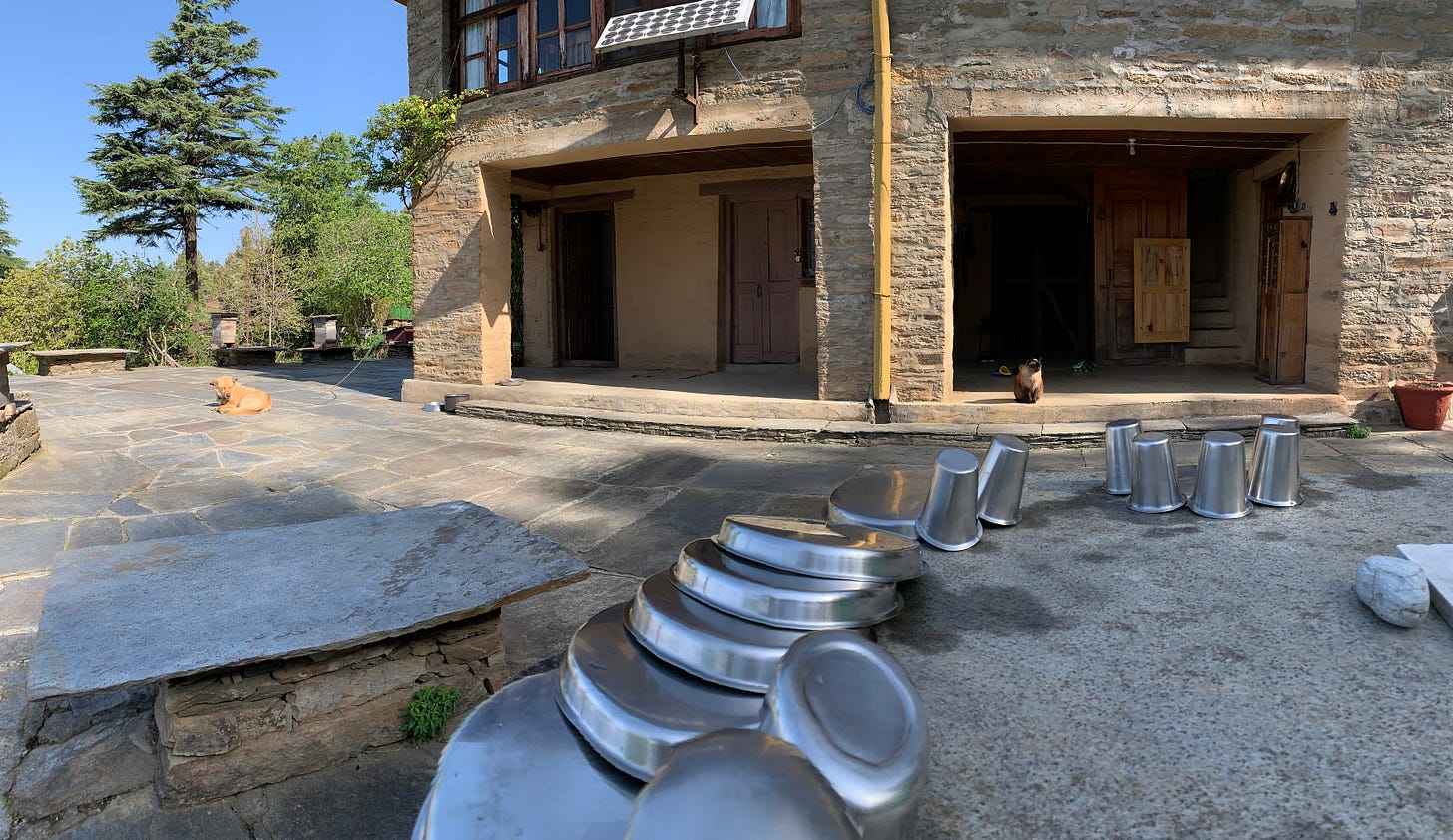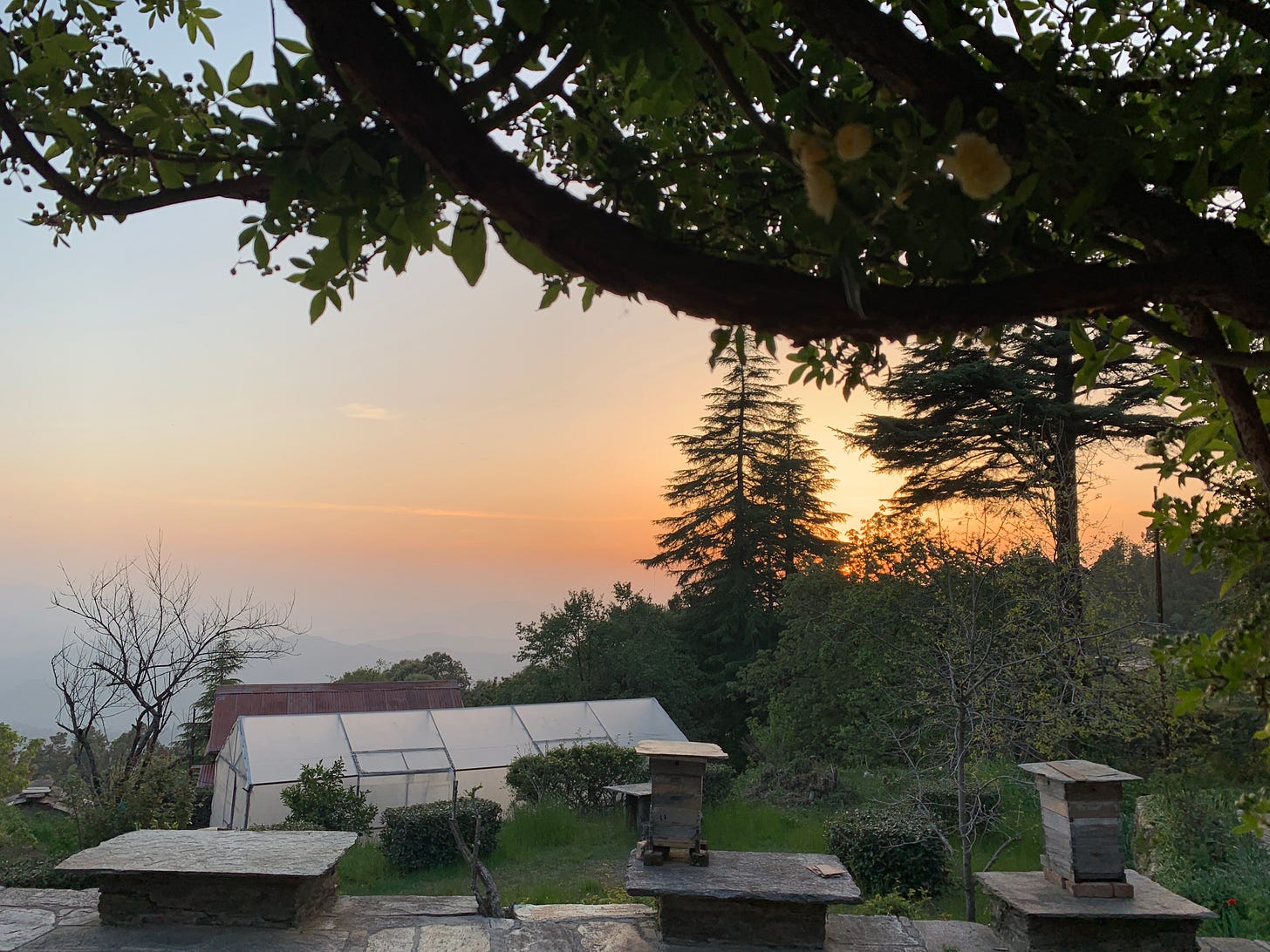Mirtola is where I first noticed that it was more than just a strand or two of silver in my hair. As I lifted away a tuft of hair from my scalp, peering into the freckled mirror tacked to the bathroom wall, the heft of lost time dawned on me. Age had been conspiring against me, and I had failed to notice it all this while. But Mirtola was hardly the place for vanity.
I must confess, though, that I had brought with me a bag full of makeup—three types of concealers, lash-plumping mascara, and lipsticks in red, oxblood and nude. Incidentally, this bag lay buried deep in my suitcase and remained entirely untouched in the days that followed.
Ensconced in a remote village in the Kumaon hills of Uttarakhand, Mirtola ashram was set up in 1929 by Sri Yashoda Ma, a housewife turned ascetic (read more about her here: https://bit.ly/2Wtvh1s). The ashram estate is built around a small temple structure with a shrine that marks the presence of Radha and Krishna. The ashram, with its handful of residents, espouses a soil-to-soul philosophy. The fecund, self-sufficient estate overlooks the glorious Himalayan mountains that are set against a clean sky that sometimes bleeds blue, sometimes crimson. What was I doing at such a place, you may ask. I have an answer to that question, but it is one that only makes sense in my private universe of chance encounters (read: divine coincidences).
It has taken me a whole year (and some) since my visit to write this piece. Back from Mirtola, I had carried with me so much by way of experiences that have coalesced into me, as it were. To give it a language is like having to describe what you see in the mirror—what a daunting task!
For days after I returned home, my suitcase lay unpacked, standing obtrusively in the centre of my room, serving as a nostalgic barrier between the world outside and the one within. For a long time, I remained unwilling to unpack what I had brought back with me. There wasn’t a soul who didn’t ask me about the place, but to each I would say, “I will write about it”. A year later, it is still particularly difficult to write about Mirtola.
Upon arriving at the monastery at the end of a daylong journey—seven hours by train, four by road—I was greeted by Rajeev and Madhu (the dearest friends I have ever had) who, in the midst of their daily chores at the ashram, looked like they truly belonged there. Shortly after, Madhu escorted me to the ashram’s ‘luxury’ cottage, where I was to stay. A short distance from the temple and the kitchen—the hub of activity at the ashram, my cottage was located at the mouth of a forest area that inspired fear and awe at once. Most certainly, the cottage was no less than what you could have asked of an extravagant resort in the mountains. What was such a cottage doing at an ashram, you may ask. To this, there is an answer that you will find as you read along.
At Mirtola, I delighted in the simplicity of the food—a freshly baked warm roti, with a humble serving of homemade pickle (there was marmalade, too, but I chose to indulge my savoury taste buds). On occasion, we would brew some coffee using the South Indian filter that we discovered in the recesses of the kitchen. One afternoon, we chanced upon sachets of Starbucks instant dark roast, tucked away somewhere in the pantry, reminding us that the other world is never too far behind. One night, we ate pea soup and grilled cheese as we pored over the ashram’s archive of letters exchanged on the subjects of love and longing.
Delightful also was the nuance and authenticity of nearly every conversation—what a wonderful escape this was from the hollow banter and ingratiating cacophony of the world to which I belonged. Among other things, I remember making my way through the soothing library atop the greenhouse, the nighttime discussions on the lives that we had—by then—lived and not yet, the post-dinner readings in the cozy tea verandah that overlooked the mountains, the incredible animals—the dog who became as friendly as she was fierce when I first walked in, the cat who remained an abiding audience to our every conversation, the meddling presence of the bees and the enormous mountain spiders (whom I suddenly no longer feared), the manner in which my skin gave way under the resplendent mountain sunshine (and how I no longer cared to slather on the sunscreen that I had made sure to carry with me) as I meticulously chopped vegetables on the patio, how we made sure to take in the night sky that brimmed bright, identifying constellations we had never seen before. Among other things, it was also delightful to revisit the tender writings of Somerset Maugham.
A sense of guilt must tinge every experience from which you have gained so much—I’m afraid that I may have escaped toiling as hard as I could have. I used to awake only minutes before the morning aarti, somnambulating my way to the temple, only to find the others already having busied themselves. But as I acted out my chores through the day, I couldn’t help but notice how rejuvenated I felt—every act of physical labour was like an offering to the mind. It was a meditation, through which the carefully constructed barriers of class (and gender), one’s relationship with physical and mental labour, and even the trifling experience of disgust upon rinsing soiled utensils, began to embody a new discourse. Even my eczematous finger became an eager participant.
Every trace of disease seemed to have spared my body and mind (I had, by then, been in the grips of acute health anxiety for several years already), or perhaps the mind-body had learnt newer languages of self-expression.
Three times a day, at six am, noon and six pm, when we assembled at the temple for the short, wordless aarti, I vanished into the recesses of the softly lit anteroom of the shrine, and meditatively struck the gong. On my last round of temple duty, while playing the gong, I happened to strike an entrancing rhythm with the other instruments at play. The resonance of that tune was magical, uplifting, and entirely otherworldly. It still rings clear within me, awakening my quietude anew.
For much of my life, I have prided myself on having no religious or spiritual inclinations—the kind of thing that would be lauded by the modern-day discourse on ‘rationality’ or ‘intellect’. At Mirtola, I started out by looking at some of the mores with suspicion, only until I became acquainted with the meditative nature of these non-dogmatic, non-prescriptive pursuits. Through the boundless freedom that that offered me, I found myself anchored in my sunburnt skin, greying hair, and an unbecoming self that was half-loved, half-lost.
Upon returning from a holiday, which is a phase of leisure that has often followed one of great longing, we are greeted by what we might find to be a lull. We might at times return feeling rather depleted. Although I spent a little less than five days at Mirtola, I returned home feeling entirely restored—as if I had brought something back with me, rather than having left something behind. In the days to follow, I played on loop the music that I had listened to in the car on our return journey, as we drove back to the plains from where I was to board my train back to Delhi. That playlist still transports me to Mirtola, sometimes.
Soon after I returned to Delhi, I started reading Faith & Fire: A Way Within, Madhu’s memoirs published in 1997 of the seven years that she and Rajeev lived at the ashram, along with seven other married couples (a monastery for married couples might sound unlikely—but who needs more introspective and self-reflective healing than two people who are married to each other!).
While staying at the cottage, which had been built by one of the couples (of whom I then knew nothing) that resided at the ashram for much of their lives, I started taking in the details of my surroundings.
This was a single-storeyed abode, sprawling by the standard. I found the openness of the layout quite appealing. The kitchen was certainly that of an aesthete’s—pots, pans and cutlery most tastefully curated. The bathroom notably belonged to someone who loved glimpses of their appearance here and there. The toilet was sectioned away from the shower—I wondered if they were Westerners, whose disdain for a damp bathroom was evident. The wardrobes in the cottage opened to the tinkling of countless clothes hangers that now hung bereft. The large windows of the cottage offered a spectacular view of the mountains. The living space had an enchanting fireplace and sophisticated furnishings, but no shelves for books! Perhaps they were not readers. During my visit, I wandered through the cottages that had been built by the other couples that were once residents, and decided that I liked mine the best.
Through the days, I had been sharing these observations with Rajeev, but had requested him not to confirm or deny my impressions of the original residents of my cottage. It was only towards the end of my visit that Rajeev confirmed many of my detailed observations, and bestowed on me the fond title of ‘Shirley Holmes’. He told me that among all the couples that had lived at the ashram, this was the only one to have eventually gotten divorced. The openness of the layout that deterred a sense of intimacy, the many mirrors that offered a dizzying number of reflections, and the inordinate space allocated to the collection of the clothes, had indeed added up. I had also been right about the bathroom—one of the residents was, in fact, a Westerner.
I had already known Madhu closely for about a year before I went to Mirtola, but it was only at Mirtola that I spent more time talking to Rajeev, realizing how fortunate I am to have met such an extraordinary human being. Through his remarkable sagacity, boundless compassion and egoless pursuit of knowledge, he has so much to offer this world. I particularly enjoyed my discussions with him on our readings of Freud, Erikson and Kakar—the delightful patriarchs of psychoanalysis, on homeopathy—its comprehensive cures much like that of psychoanalysis and the manner in which the modern world frowns upon it, on my evolving relationship with food and its impact on my relationship with my primary caregivers—or was it the other way round? We discussed in detail our nightly dreams, as Madhu created for us an insightful presentation on dream theory. Every now and then, our conversations invariably meandered into the world that we had to return to. We spoke about the then upcoming Lok Sabha elections, and it was reassuring to count on the fear of despotism that united us all. We talked of the subject of love, and I chimed in with my cynicism that looks at love as a narcissistic pursuit, where the object of love is but a mirror to the self. For a brief while, I let my ideas on these subjects become a source of undue self-importance, even as the preoccupations with the body and the need for makeup had stepped aside.
It is a matter of little surprise that in the last year, fear, vanity, jealousy and despair have crawled back into my life, as they do. But every time I think of Mirtola, I seem to regain the superpower that is self-reflection. In all the time since, Mirtola has been remembered as a benevolent mirror—the one that will forever be tacked on the wall of my life.
Read more about Mirtola here: http://www.mirtolareflections.com/index.html






